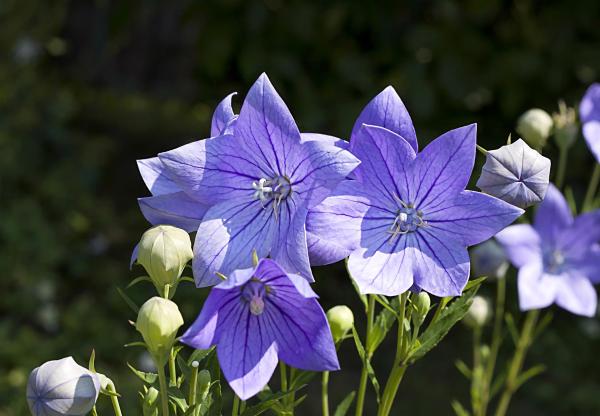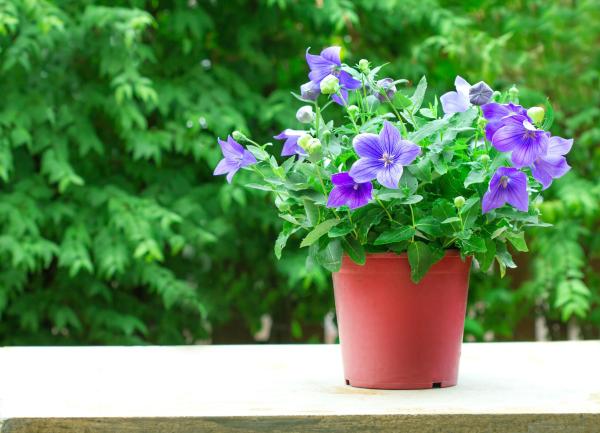Caring for a Chinese Bellflower Plant (Platycodon grandiflorus)


The plant known as Chinese bellflower or balloon flower (Platycodon grandiflorus) is the only species of the genus Platycodon. They are a plant with beautiful blue flowers which bloom in the shape of a bell, hence their name. Native to Asia, they are a perennial plant with a natural habitat of mainly mountains and fields. For this reason, they are generally pretty tolerant of sun exposure, although they will fare best with periods of shade. Not only is the Chinese bellflower very beautiful, but it is also one of the easiest flowering perennials to care for.
Despite being and easy-to-care-for plant, there are certain care guidelines you need to follow if you want to have a healthy Chinese bellow flower plant. thedailyECO explains what these are with our complete guide to caring for a Chinese bellflower plant (Platycodon grandiflorus).
Characteristics of the Chinese bellflower
As stated in the introduction, the Chinese bellflower is the only species of the genus Platycodon, even sometimes simply being referred to as platycodon plants. This is a type of ornamental plant which has the following characteristics:
- Its unique appearance is due to its traditionally blue bell- or star-shaped flowers, making it a great ornamental plant for gardens. These flowers bloom from the last days of spring until the end of summer. They are large and measure about 2" (5 cm) across.
- Although there is only one species of platycodon, this plant has variations in color and size. This is due to cultivars being created by horticulturalists, as well as different colors being more prominent in different regions. For example, white flowers are generally more common in Korea.
- When the buds are closed they look like a Kongmíng lantern (Chinese sky lanterns), with all the petals gathered in the center and an inflated interior. It is for this reason they can also be found under the name of balloon flower.
- The stems grow in clumps and are 12" (30 cm) tall.
- It is a herbaceous plant that grows in the form of a shrub and sometimes may need support to stay upright.
- The leaves are green and slightly gray on the underside. In the fall they can turn yellow, but there is nothing to worry about because it is normal stage of their life cycle.
- It is native to East Asia, and the root is often used for food and traditional medicinal purposes due to its large amount of flavonoids and saponins.
- It is perennial and lives for a long time. It is also a relatively easy plant to maintain because it does not require complex care and it is not particularly prone to pests or diseases.

Where to place a Chinese bellflower
The Chinese bellflower thrives in areas ranging from direct sun to partial shade. It can withstand low temperatures. Since it is a perennial, it should not perish during the winter. Its subterranean tuberous root will flower again during the next spring. Although hardy, it should be protected from frost if it is being kept in a pot. We should not move it around, so leave it in a permanent place once potted. It is often sown directly into the soil of flowerbeds.
Chinese bellflower soil and compost
It grows in virtually any type of soil, but appreciates a well-draining substrate. It also does well in average to nutrient-rich soil. To achieve such a soil, a mixture of universal soil based on peat and earthworm humus will be prepared in equal parts, adding a handful of tepojal or vermiculite. Learn how to make your own worm castings at home with our related article.
Annual fertilization is not usually essential. If you do want to fertilize the Chinese bellflower, compost can only be added to the top in the spring to improve soil quality. It is recommended to put leaf mulch on top to keep away unwanted weeds.

Watering the Chinese bellflower
Among the qualities that make the Chinese bell an easy-care plant is the demand for water, since it does not require abundant watering. It must be carried out sporadically and we need to use soil with good drainage to avoid oversaturation. Seasonal Chinese bellflower irrigation should be carried out in the following ways:
- In the spring and summer season, 3 times a week is plenty.
- For autumn and winter it should be spaced out more, with once a week being the maximum.
This complete guide to caring for the Chinese bellflower is needed for this type of perennial plant. Learn about caring for other other garden flowers with our article on types of annual plants.
Chinese bellflower pruning
To promote a healthy bloom of the Chinese bellflower, it is necessary to remove any already decayed or dead flowers. This will lengthen the flowering season. In case of frost, it is recommended to cut the stems. New plants will emerge from them later, so you have to remember the space where they were so as not to inadvertently remove them completely.
The stems and leaves take a while to emerge after pruning. This is normal and does not mean there is something wrong with the plant. You just have to be patient for it to return to its standard height.
The plant has a beautiful aesthetic and is often used to make flower arrangements. If you want to try making one at home, it is recommended to burn with a lighted match where the flower was cut. This is because Chinese bellflower exudes a white juice or milk when cut and burning will reduce the suppuration of this liquid. After burning, the cut plant will be conditioned by placing it in warm water. It can then be transferred to a glass with water or as a decorative flower.

Reproduction of the Chinese bellflower
There are two methods to reproduce the Chinese bellflower:
- Transplantation: for this process , those new plants that appear from the initial plant will be separated to transplant them to a new substrate. This division must be done when the plant measures at least 1.2" (3 cm), and preferably the roots of the daughter plant must be immersed in growth hormones before placing them in the ground. The roots are very fleshy, so care must be taken when dividing so as not to break or injure them.
- Seed reproduction: it must be taken into account that the flowering time by this method is very long, the bells appearing up to 2 years later. Seeds are planted in spring or early fall for best results. Consider placing them about 12 inches apart so they have plenty of room to develop once they reach full size.
While the blue flowers of Platycodon grandiflorus are undoubtedly beautiful, there are many different types of flower you may want to plant in your home or garden. Get some inspiration with our guides to white flower plants for the garden and plants with black flowers.
If you want to read similar articles to Caring for a Chinese Bellflower Plant (Platycodon grandiflorus), we recommend you visit our Plant care and cultivation category.
- Cox, J. (1998) Perennial All-Stars . Pennsylvania: Rodale Press.
- Ellis, B. (1998) Taylor's Guide to growing North America's favorite plants . United States: Houghton Mifflin Company.








